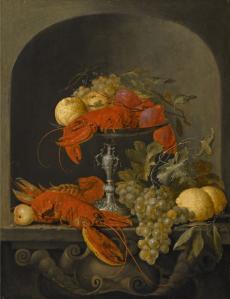


In a dark niche above a sculpted frieze stands a large silver tazza, upon which lie a red lobster, a branch full of red plums, two lemons and a bunch of grapes. On the ledge to the left of the tazza more lobsters are represented, as well as a peach. On the right, we see two lemons with their leaves and a big bunch of grapes with its graciously draped vine foliage. The powerful reds, yellows and greens impart to the painting, with its costly tazza and food, a splendid, rich appeal, which is further accentuated by the lighting from the left. The painting does not carry a signature, but the composition relates closely to the work of Jan Davidsz. de Heem. An identical panel from his hand bears his signature and a date in the bottom centre: J. De heem. fecit.A° i646. At least four other versions of this composition are known, one of which was attributed by Fred G. Meijer to Alexander Coosemans (1627-1689), who was a pupil of de Heem in Antwerp between 1641 and 1645. Another one, in the Kunstmuseum Basel, has more variation and was attributed to Laurens Craen (c. 1620-1666/71), a Middelburg follower of de Heem. A related version, signed by the Antwerp master Joris van Son (1623-1667), is in the Musée de l’Hôtel Lallement at Bourges.
It seems that de Heem kept his original work in his studio for some time, where copyists had access to it. This is, in any case, true for the version in the A. G. Leventis Collection, because the panel and the paint date from the 17th century and the execution of the picture may be called very good, if not excellent. It is by far the best version known today and the one which is most faithful to de Heem’s original composition. It is therefore acceptable to attribute the A. G. Leventis Collection version to the studio of the master. We must not forget that copying the work of the master was an accepted practice and even an essential part of a pupil’s training, and de Heem had many pupils, including his three sons. Moreover, the artist himself sometimes made copies of his own compositions. One example is the Still Life with Fruits and a Festoon with a Lobster, of which both the Museum der Bildenden Künste in Leipzig and the Gemäldegalerie Alte Meister in Dresden have signed versions from de Heem’s own hand. Jan Davidsz. de Heem was without doubt the most influential still-life painter in 17th-century Dutch and Flemish painting. In addition to his many pupils, he also had a mass of followers, both in Antwerp in the Southern Netherlands, and in Leiden and Utrecht in the North. He was born in Utrecht in 1606 as Johannes van Antwerpen and he probably learnt to paint in the studio of the flower specialist Balthasar van der Ast (1593/4-1657). At an early age he moved to Leiden, where he lived from about 1625 until 1631. There he got married in 1626. Afterwards he went to Antwerp, where he became a member of the painter’s guild in March 1636 and even took up citizenship in 1637. In 1644, after the death of his first wife, de Heem remarried, to a daughter of the well-known builder of harpsichords and virginals Andries Ruckers (1579 – after 1645); the famous Flemish painter Jacob Jordaens (1593-1678) acted as a witness. De Heem was often absent from the city, as attested by the duties he had to pay for this. From December 1658 until December 1663 he was not in Antwerp anymore and he must have travelled regularly to Utrecht, where he is recorded in January 1665. Four years later he became a member of the Utrecht painter’s guild. He left Utrecht in 1671, when French troops were approaching the city. He finally returned to Antwerp, where he died between October 1683 and May 1684.
De Heem can be considered the originator of the so-called ‘pronk’ still life, the sumptuous still life, of which this painting is a good example. It is a relatively large work, displaying wealth with a selection of costly objects and food: a large silver tazza, several lobsters and Mediterranean fruit. Also, the sculpted frieze under the stone ledge has a richer impact than the wooden table ledge normally preferred as a support on which still-life elements are presented.
De Heem was perhaps the most influential still-life painter in 17th-century Dutch and Flemish painting. Bornin Utrecht and then moving between Leiden and Antwerp, he can be considered the originator of the so-called‘pronk’ still life, the overt display of sumptuous luxury items, expensive foods and exotic fruits, in which hecombined brilliant colours with an accurate rendering of objects. With a considerable reputation and manycommissions, de Heem was assisted in his studio by his three sons and several apprentices.